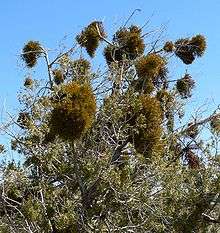Phoradendron juniperinum
| Phoradendron juniperinum | |
|---|---|
 | |
| juniper mistletoe in host tree | |
| Scientific classification | |
| Kingdom: | Plantae |
| (unranked): | Angiosperms |
| (unranked): | Eudicots |
| (unranked): | Core eudicots |
| Order: | Santalales |
| Family: | Santalaceae |
| Genus: | Phoradendron |
| Species: | P. juniperinum |
| Binomial name | |
| Phoradendron juniperinum Engelm. ex A.Gray | |
| Synonyms | |
Phoradendron juniperinum is a species of flowering plant in the sandalwood family known by the common name juniper mistletoe. It is native to the southwestern United States and northern Mexico, where it grows in various types of woodland habitat. It has been reported from California, Nevada, Arizona, New Mexico, Oregon, Utah, Texas, Chihuahua and Sonora.[2]
This mistletoe parasitizes species of juniper, including Utah (Juniperus osteosperma), Rocky Mountain (J. scopulorum), and western juniper (J. occidentalis).[3]
It is a shrub producing many erect and spreading yellow-green branches 20 to 40 centimeters long from a woody base where it attaches to its host tree, tapping the xylem for water and nutrients. It is hemiparasitic, meaning it contains some chlorophyll and can photosynthesize some energy for itself as well. The smooth, noded branches have flattened, scale-like leaves. The plant is dioecious, with male and female individuals producing different forms of inflorescence with knobby flower clusters. Female flowers yield shiny light pink spherical berries each about 4 millimeters wide.
Birds eat the fruits and excrete the undigested seeds on tree branches, where they root.[3]
Uses
Several Native American tribes used this mistletoe for medicinal purposes, for teas, and at times for food.[4] Among the Zuni people, an infusion of whole plant is used for stomachaches.[5] A compound infusion of plant taken to promote muscular relaxation at birth, and a simple or compound infusion of twigs taken after childbirth to stop blood flow.[6]
See also
| Wikimedia Commons has media related to Phoradendron juniperinum. |
References
- ↑ Tropicos, Phoradendron ligatum
- ↑ Hawksworth, F.G., & D. Wiens. 1993. Viscaceae, Mistletoe Family. Journal of the Arizona-Nevada Academy of Science 27:241-245.
- 1 2 A Field Guide to Diseases & Insect Pests of Northern & Central Rocky Mountain Conifers: Juniper Mistletoe
- ↑ Ethnobotany
- ↑ Camazine, Scott and Robert A. Bye 1980 A Study Of The Medical Ethnobotany Of The Zuni Indians of New Mexico. Journal of Ethnopharmacology 2:365-388 (p. 377)
- ↑ Stevenson, Matilda Coxe 1915 Ethnobotany of the Zuni Indians. SI-BAE Annual Report #30 (p. 55)